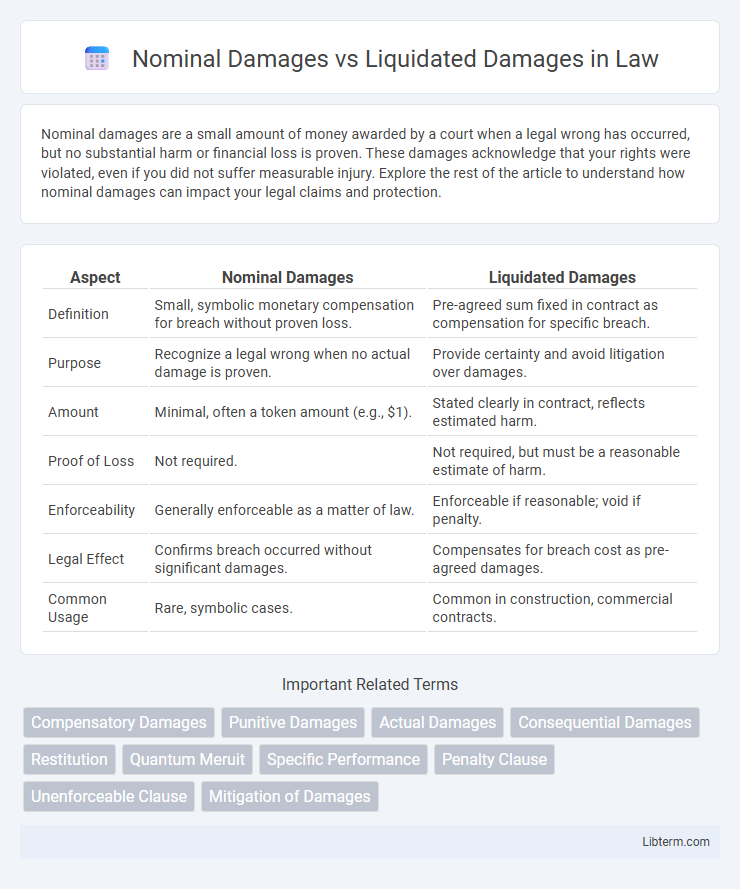Nominal damages are a small amount of money awarded by a court when a legal wrong has occurred, but no substantial harm or financial loss is proven. These damages acknowledge that your rights were violated, even if you did not suffer measurable injury. Explore the rest of the article to understand how nominal damages can impact your legal claims and protection.
Table of Comparison
| Aspect | Nominal Damages | Liquidated Damages |
|---|---|---|
| Definition | Small, symbolic monetary compensation for breach without proven loss. | Pre-agreed sum fixed in contract as compensation for specific breach. |
| Purpose | Recognize a legal wrong when no actual damage is proven. | Provide certainty and avoid litigation over damages. |
| Amount | Minimal, often a token amount (e.g., $1). | Stated clearly in contract, reflects estimated harm. |
| Proof of Loss | Not required. | Not required, but must be a reasonable estimate of harm. |
| Enforceability | Generally enforceable as a matter of law. | Enforceable if reasonable; void if penalty. |
| Legal Effect | Confirms breach occurred without significant damages. | Compensates for breach cost as pre-agreed damages. |
| Common Usage | Rare, symbolic cases. | Common in construction, commercial contracts. |
Introduction to Contractual Damages
Contractual damages address breaches by compensating the injured party based on predefined or actual losses. Nominal damages represent a token sum awarded when a breach occurs without significant financial harm, serving to acknowledge the breach legally. Liquidated damages involve a specific amount agreed upon in the contract, intended to estimate potential losses and provide certainty in enforcement.
Defining Nominal Damages
Nominal damages are a small, symbolic monetary award granted by courts when a legal wrong has occurred without resulting in substantial loss or injury, emphasizing the recognition of a breach rather than compensation. They typically amount to a minimal sum, such as one dollar, serving to affirm the plaintiff's rights without addressing actual financial harm. Unlike liquidated damages, which are predetermined amounts specified in a contract to cover potential breaches, nominal damages acknowledge a technical violation without quantifying specific damages.
Understanding Liquidated Damages
Liquidated damages represent a pre-agreed sum specified in a contract, intended to compensate for potential losses when actual damages are difficult to quantify. Courts enforce liquidated damages only if the amount is a reasonable estimate of anticipated harm and not a penalty designed to punish breach. Understanding liquidated damages ensures parties allocate risk effectively and avoid prolonged litigation over damage assessments.
Key Distinctions Between Nominal and Liquidated Damages
Nominal damages represent a minimal sum awarded when a breach of contract occurs without substantial loss, primarily serving to acknowledge the violation. Liquidated damages are predefined amounts agreed upon within a contract, intended to estimate actual harm in cases where calculating precise damages is challenging. The key distinction lies in nominal damages reflecting token compensation for technical breaches, whereas liquidated damages provide enforceable, pre-calculated damages that both parties have consented to prior to contract formation.
Legal Purposes of Nominal Damages
Nominal damages serve primarily to acknowledge a legal wrong when no actual financial loss has occurred, reinforcing the plaintiff's rights without awarding substantial compensation. These damages are often used to establish a precedent, confirm a breach of contract, or support requests for injunctive relief. Unlike liquidated damages, which represent predetermined sums agreed upon in contracts to cover estimated losses, nominal damages focus on legal recognition rather than compensation.
Legal Purposes of Liquidated Damages
Liquidated damages serve as a pre-agreed sum specified in contracts to compensate for potential breaches when actual harm is difficult to quantify, ensuring predictable legal remedies. They are enforced to provide certainty and avoid protracted litigation over damages in contractual disputes, particularly in construction and service agreements. Unlike nominal damages, which recognize a breach without substantial loss, liquidated damages reflect a genuine attempt to estimate potential losses at the time of contracting.
Common Scenarios for Awarding Nominal Damages
Nominal damages are commonly awarded in contract disputes where a breach has occurred but no substantial financial loss can be proven, serving as a legal recognition of the violation. Typical scenarios include cases involving technical breaches, such as failure to perform a minor contract obligation or unauthorized use of property with negligible harm. Courts grant nominal damages, often a token sum like one dollar, to affirm the plaintiff's rights without imposing significant monetary compensation.
Typical Situations for Liquidated Damages Provisions
Liquidated damages provisions are typical in construction contracts and service agreements where actual damages are difficult to quantify or prove. These clauses pre-define a monetary amount payable if a party breaches the contract, ensuring predictability and reducing litigation risk. Courts generally enforce liquidated damages when the stipulated sum represents a reasonable estimate of anticipated harm rather than a penalty.
Judicial Interpretation: Nominal vs Liquidated Damages
Judicial interpretation distinguishes nominal damages as a symbolic sum awarded when a breach occurs without measurable loss, emphasizing legal recognition rather than compensation. Liquidated damages, however, represent a pre-agreed sum stipulated in a contract to compensate anticipated losses, subject to court scrutiny for reasonableness and not serving as a penalty. Courts analyze the intent and proportionality of liquidated damages clauses, ensuring they reflect genuine pre-estimates of harm, contrasting with nominal damages that simply affirm a right infringement.
Practical Implications and Best Practices for Drafting Damages Clauses
Nominal damages serve as a symbolic recognition of a breach without substantial loss, while liquidated damages represent a pre-agreed sum estimated to cover potential actual damages. Practical implications dictate that liquidated damages clauses must be reasonable and reflect genuine pre-estimates to avoid being deemed punitive and unenforceable. Best practices for drafting damages clauses include clear definitions, specifying calculation methods, and ensuring compliance with jurisdictional standards to enhance enforceability and predictability in contractual disputes.
Nominal Damages Infographic

 libterm.com
libterm.com